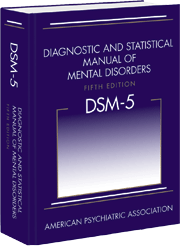The latest edition of the manual defining criteria for mental illness is set to have a major impact on how patients are diagnosed and how their treatment is funded.

Walk into the office of any psychiatrist or psychologist and one item is guaranteed to be on the book shelf: the Diagnostic and Statistical Manual of Mental Disorders (DSM).
Often called the ‘psychiatric bible’, the DSM is published by the American Psychiatric Association (APA) and contains descriptions, symptoms, and other criteria for diagnosing mental disorders. These criteria for diagnosis provide a common language among professionals who treat patients with mental disorders.
The Manual’s fifth edition, DSM-5, is to be launched at a press briefing at the APA conference in San Francisco this Sunday (NZT).
Some of the proposed changes likely to be included in the new DSM — which hasn’t been updated since 2000 — have gathered considerable criticism from both experts and the public. Controversial revisions include:
- Re-classifying Asperger Syndrome under the broader Autism Spectrum Disorder diagnosis.
- Removal of certain exclusion criteria separating bereavement grief and depression.
- A broader definition of attention deficit hyperactivity disorder (ADHD)
- A reshuffle of diagnostic criteria for post traumatic stress disorder (PTSD).
An open letter criticising some of the DSM-5 revisions has so far gathered gathered more that 14,000 signatures.
Ahead of Sunday’s launch of the DSM-5, the SMC contacted New Zealand experts for comment on the new edition and its implications for NZ. Feel free to use these quotes in your reporting. If you would like to contact a New Zealand expert, please contact the SMC (04 499 5476; smc@sciencemediacentre.co.nz).
Peter Coleman, President of the New Zealand Psychological Society, and Kerry Gibson, President Elect, comment:
“We, like many psychologists around the world, are concerned that the changes in the DSM are not supported by clear research evidence. As is generally recognised, DSM has always been a consensus document and in part reflects changes in social norms and beliefs (e.g. homosexuality was once listed as a mental disorder) as much as empirical research.
“The fact that the DSM-5 has lowered the threshold for some diagnoses and added a number of additional diagnoses raises the risk of giving a mental health diagnosis to someone who may simply be experiencing normal problems of living. In DSM IV, for example, a diagnosis of depression specifically excluded people who had lost a loved one up to two months previously. The removal of this criterion in DSM-5 creates potential for people suffering understandable grief to be diagnosed with depression and treated with antidepressants. In another change, Aspergers Syndrome disappears and has been absorbed into a uni-dimensional Autistic Spectrum Disorder.
“Whilst such changes might be confusing for many people, psychologists are trained to use their clinical judgement rather than blindly following a diagnostic manual in working with their clients and it is unlikely that their day-to-day practice will be affected by such diagnostic changes.”
Associate Prof David Menkes and Prof Graham Mellsop, Department of Psychological Medicine, Waikato Clinical School, University of Auckland, comment:
“The launch of DSM-5 this weekend will rightly attract media interest from around the world. Mental disorders are common in New Zealand, as everywhere, and because of their complexity, are challenging to understand both for mental health professionals and the public.
“Systems of classification, such as DSM-5, are important because they shape our understanding of what constitutes illness and, in large measure, what we can do about it.
“There are both benefits and harms that can come from use of a classification system, and DSM-5 is no exception. It’s important to keep the benefits in mind but also to be fair and honest in the criticism of such systems. With regard to DSM-5, the main criticisms are likely to centre on ‘overdiagnosis’, the process by which medical diagnoses are applied inappropriately and/or harmfully. For example, using DSM-5 criteria, normal human sadness following bereavement (or being forced to resign from parliament) may be inappropriately labeled as a medical illness “major depression”. Such labels may not help clinicians understand their patients, nor do they necessarily provide guidance on what intervention — if any — is appropriate.
“On the other hand, it should be borne in mind that diagnosing depression can also be useful, even life-saving, in many cases. Human beings are complex, and a simple criterion-based or ‘checklist’ diagnosis may not be as valid as that offered by a perceptive, skilled and highly-trained clinician.
“There is also the issue of diagnostic complexity. DSM-5 contains approximately 400 separate diagnostic entities. Surveys of New Zealand and overseas psychiatrists showed that most would prefer simpler (and arguably more valid) classifications with less than 100 entities. Related to DSM’s complexity and the problem of overdiagnosis is the concept of ‘comorbidity’, where multiple mental disorders may coexist in the same individual at the same time. Many experts believe that DSM-5 will foster such needless labeling when the real issue is the complexity of the underlying disorder.
“Many of the diagnostic categories in DSM-5 are based on symptoms reported to the clinician. Such symptoms are subjective and of doubtful validity in many cases. The results of clinical trials, for example of antidepressants, are also often based on improvement in the same subjective symptoms. Recently there has been increasing emphasis on function as a criterion of illness, need for treatment, and as a marker of recovery. Unfortunately DSM-5 seems to do little to support this important development.
“Finally, DSM classifications were developed in North America in part to determine Americans’ access to treatment and how psychiatrists are paid. This is of questionable relevance to the needs of New Zealanders and our smaller, more efficient healthcare system.”